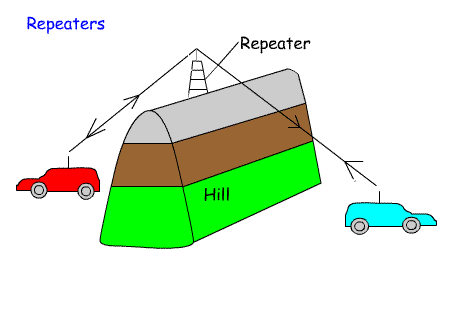
| ADVANCED LESSON 64 |  |
| LEARNING OBJECTIVES and NOTES | |||||||||||||||||||||
| Operating Practices and Procedures - Repeaters | |||||||||||||||||||||
|
8b.1 Recall the purpose and operation of repeaters and the correct
procedures in using them. E.g. offsets on 144 and 433MHz; time-out and
reset tone; voice procedures. Repeaters are designed to extend the range of communications, particularly for mobile stations. For example in a hilly area two stations in adjacent valleys with a high ridge between them would not be able to make contact. By putting a repeater on the ridge, the repeater will be able to relay the information to and from each station. A repeater is normally located on a high point with a good coverage of the local area. At the repeater site there is a receiver tuned to the input frequency and a transmitter tuned to the output frequency. The output from the receiver is connected to the input to the transmitter. There is also a logic board to control the system. The spacing between input and output depends on the band. On 2m it is 600kHz (The repeater transmits on a frequency 600 kHz higher than its receive frequency) and on 70cm it is 1.6MHz (The repeater transmits on a frequency 1.6MHz lower than its receive frequency) For example the GB3AS repeater has an output on 145.600 MHz and an input on 145.000MHz. GB3DV has an output on 433.025MHz and an input on 434.625MHz. To limit the time for a transmission, many repeaters are fitted with time-out logic. These start when the repeater is accessed and after a set time - say 2mins- the transmitter is turned off and has to be re-accessed. When not in use repeaters are silent. They are turned on when a carrier and a reset tone (1750Hz) and sometimes speech are received. Repeaters are now turning over to use a CTCSS tone which is a low frequency tone which is on throughout the transmission. The are CTCSS tones vary from region to region. CTCSS stands for Continuous Tone-Coded Squelch System. The 1750Hz tone is being phased out of use. The procedure for a repeater contact is as follows
|

You do not need to learn this! |